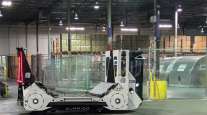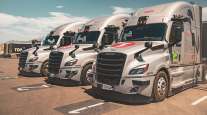Automation and New Vehicle Technology Bring New Challenges

[Stay on top of transportation news: Get TTNews in your inbox.]
PHOENIX — The amount of safety technology available to fleets has exploded over the past 20 years, creating a new intersection of safety, technology and regulation that is becoming even more complex as autonomous solutions increase.
“It is a little bit of the Wild West with applying advanced controls that are designed to either assist a driver actively driving a vehicle or drive a vehicle with no one there. It is a transition that is quite complicated,” said John Steiner, CEO of Mecanica Scientific Services.
Steiner, Chas Wurster, chief technology officer for PrePass, and Tim Lafon, vice president of regulatory affairs for Solera, took part in a panel discussion on automation during American Trucking Associations’ Safety, Security and Human Resources National Conference and Exhibition.
Steiner said the transition from traditional mechanical systems to autonomous technology will have a few bumps in the road, starting with driver acceptance and understanding.
Immersed in the future of transportation at #SSHR24! Today we dove into driver health, safety standards for autonomous trucks and EVs, and how to safeguard against cargo claims. Making steps towards a safer, more secure industry. pic.twitter.com/tsujCJGXzf — American Trucking (@TRUCKINGdotORG) April 26, 2024
Drivers already are using semi-autonomous functions, such as lane-keeping assistance, collision warnings and automatic braking, increasing the need for education on technology’s capabilities.
“What we’re seeing in the fleets now is a discontinuity between what the drivers think it can do and the reality,” Steiner explained.
Automation also will bring change to daily vehicle inspection reports and how drivers conduct inspections.
“Drivers now know how to do an inspection,” Lafon said. “Now, if you’re doing drive-by-wire, what does that look like? How do you inspect it? Is there something you have to run, like a test, to ensure that it is running correctly?”
If a crash occurs, carriers need to be prepared for a new type of conversation.
“When something goes wrong, not only does the fleet want to know the why, but if there is some contribution from the vehicle or technology, the manufacturer wants to know,” Steiner said. “It is a really complicated mess.”
Phoenix, you were incredible! From important discussions on trucking safety to making stronger connections, #SSHR24 was an unforgettable experience. Heads up, Louisville! We're rolling your way for #SSHR25, April 23-25. Let's keep shaping our industry's future together. pic.twitter.com/3I8XzIWemo — American Trucking (@TRUCKINGdotORG) April 29, 2024
First responders will need training on how to approach new technologies, and carriers or drivers also may have to let responding officers know if the vehicle was driving.
Regulations surrounding autonomous technology are changing rapidly. The National Highway Traffic Safety Administration has released guidance on automation.
“They said we don’t need FMVSS [Federal Motor Vehicle Safety Standards] to regulate automation. We have the safety-related defense,” Lafon said, adding that FMVSS may come later.
Check out Transport Topics' updated Top 100 list of the largest logistics companies in North America, and explore how the industry's top players have adapted to a tough freight market and are preparing for the future. Tune in above or by going to RoadSigns.ttnews.com.
Wurster said states operate differently from each other on allowable technologies, which will affect the adoption. For example, California does not allow the use of fully autonomous solutions.
Lafon said the trucking industry has been adjusting to the evolution of safety technology and regulations for more than 100 years and will continue to adapt.
“The environment changes. There are new challenges. There are new learnings,” he said.
Want more news? Listen to today's daily briefing below or go here for more info:





